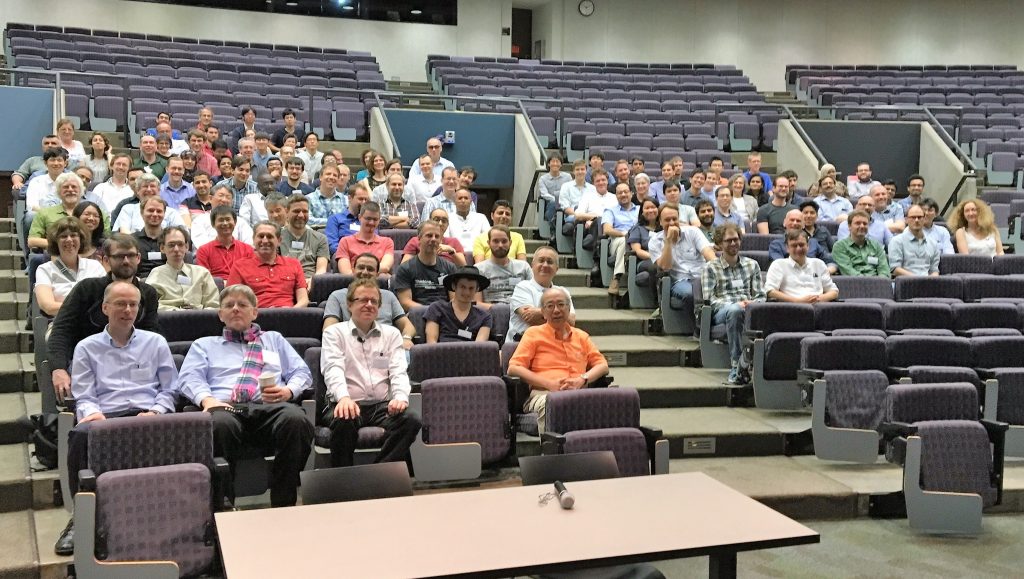Mini-course at MTNS, July 12th, 2016, Minneapolis, MN, USA
Organizers:
1-Dr. Almuatazbellah M. Boker
Marshall University, Huntington, WV, USA
Email: bokera@marshall.edu
Website: http://users.marshall.edu/~bokera/
2- Dr. Aranya Chakrabortty
North Carolina State University, Raleigh, NC, USA
Email: achakra2@ncsu.edu
Website: http://people.engr.ncsu.edu/achakra2/
3- Dr. Thomas R. Nudell
Massachusetts Institute of Technology, Cambridge, MA, USA
Email: nudell@mit.edu
Course Webpage: http://users.marshall.edu/~bokera/MTNS.html
Motivation & Objectives
Systems that communicate through networks are ubiquitous in this day and age. The complexity of such systems is continuously increasing as a result of the decreasing cost of communication (with the prevalence of the internet for example) and the growing number of smart devices used for monitoring and actuation. There is also, on the other hand, an increasing need to take the different privacy and security concerns of the interconnected systems into consideration. However, many conventional analysis and design methods, such as the ones that make use of the Information Technology (IT) concepts, may not be adequate in dealing with such systems, especially if they are dependent on central monitoring and control strategies. This necessitates the need for adapting alternative control-theoretic methods that help in re-framing the complex and potentially large-scale problems into relatively convenient ones for which efficient solutions can be found.
Taking deeper look at many natural and engineered networks, such as social networks, wireless sensor networks and power systems networks, it can be seen that they tend to be organized into a number of interconnected clusters. The notion of clustering here is loosely defined as the ratio between the strength of the internal connections to the external connections. This special structure is shown to exhibit two time-scales behavior, where the average of the states within each cluster evolve in a slower time-scale compared to the relative motion of the internal states. This motivates considering singular perturbation theory as a main tool in their analysis and control. Singular perturbation theory has been shown to be effective in dealing with systems that exhibit multi-time-scale properties. It can effectively allow us to consider each time-scale component of the system separately and, hence, can lead to considerable simplification of the entire system dynamics. By decomposing the system into its slow and fast components, one can also have a deeper understanding of the system dynamics and can design targeted control strategies independently for each time-scale dynamics. Traditionally, however, singular perturbation has been used to primarily study model reduction of standalone centralized systems without consideration to any spatial structure, and to study how these reduced-order models can be used for control designs. Our focus, in contrast, is to explore how network-theoretic concepts can be merged with these model reduction and control techniques. More specifically, we will combine graph theory and singular perturbation theory to show how network structure can be an additional design component that can be exploited for conventional singular perturbation-based designs.
From a different prospective, the majority of the so called control problems of the cyber-physical systems, where networks constitute a vital part of their structure, so far have either been addressed very incrementally, or have been defined in a broad and intuitive way without rigorous mathematical formulation. As a step towards bridging this gap, this mini-course aims to shed light on the tremendous potential of exploiting two-time-scale properties of networks for the purpose of their analysis and control.
In particular, our goal in this mini-course is to present an overview on modeling and control of multi-time-scale networked systems, to formulate problems on making the control systems distributed and scalable, and to point out how singular perturbation theory can play an instrumental role in solving these problems.
Course Textbook: Petar Kokotovic, Hassan K. Khalil, John O’Reilly, Singular Perturbation Methods in Control: Analysis and Design, Siam, 2nd Edition, 1999.
Course Structure
The course is dived into three parts. Details of these parts are given as follows.
Part 1: Singular Perturbation Theory and its use in State-Feedback Control
Dr. Almuatazbellah Boker
This part will cover the fundamental aspects of singular perturbation theory. In particular, it will cover the following topics:
1. Modeling techniques of two-time scale systems: a discussion on the standard form of singularly perturbed systems.
2. Linear time-invariant systems: brief review of block-triangular and block-diagonal forms and their eigenspace properties.
3. Composite control of linear systems with application in eigenvalues assignment scenario.
4. Composite control of nonlinear systems: stability analysis.
The slides of the presentation can be found in this link.
Part 2: Two-Time-Scale Modeling and Control of Clustered Networks
Dr. Almuatazbellah Boker
This part will cover the following topics:
1. Two-time scale modeling of clustered networks: representing clustered networks in the standard singular perturbation models; review of multi-cluster modeling technique, where each cluster can have an approximate and unique model that represents the whole network.
2. Cluster-level composite control of networks: overview of the cyber-physical structure of the closed-loop system, control aggregation concept.
3. Control problems/applications: distributed consensus control; design of robust controllers with respect to inter-cluster feedback communication delays and damping control of power networks.
The slides of the presentation can be found in this link.
Part 3: Role of Singular Perturbation for Attack Localization in Graphs
Dr. Thomas R. Nudell
This part will cover the following topics:
1. The graph Laplacian of clustered networks: eigenvalues and eigenvectors.
2. Discrete nodal domains of Laplacian eigenvectors: an introduction to basic concepts and theory.
3. Discrete nodal domains and transfer function residues: a brief theoretical foundation.
4. Tractable attack localization algorithms in clustered graphs, i.e., putting it all together: singular perturbation, transfer function residues, and discrete nodal domains.
The slides of the presentation can be found in this link.
MTNS2016 Group Picture
